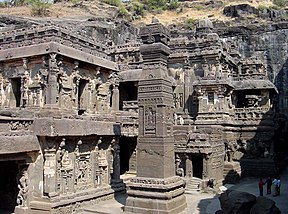
Back العمارة الهندية المنحوتة في الصخر Arabic Arquitectura tallada en la roca a l'Índia Catalan Arquitectura tallada en la roca en India Spanish Architecture taillée dans la roche en Inde French भारतीय शैलकर्तित वास्तुकला Hindi Arkitektura shkëmbore e Indisë Albanian 印度岩雕建築 ZH-YUE
| Art forms of India |
|---|
 |
Indian rock-cut architecture is more various and found in greater abundance in that country than any other form of rock-cut architecture around the world.[1] Rock-cut architecture is the practice of creating a structure by carving it out of solid natural rock. Rock that is not part of the structure is removed until the only rock left makes up the architectural elements of the excavated interior. Indian rock-cut architecture is mostly religious in nature.[2][3]
There are more than 1,500 known rock-cut structures in India. Many of these structures contain artwork of global importance, and most are adorned with exquisite stone carvings. These ancient and medieval structures represent significant achievements of structural engineering and craftsmanship.[4] The effort expended often astonishes visitors, but seen from one aspect, a rock-cut structure is a decorated rock quarry; most of the stone removed was typically put to economic use elsewhere.[citation needed]
In India, caves have long been regarded as sacred places. Caves that were enlarged or entirely man-made were believed to be as sacred as natural caves. The sanctuary in all Indian religious structures, even free-standing ones, was designed to have the same cave-like feeling, as it is generally small and dark, without natural light.[5] The oldest rock-cut architecture is found in the Barabar caves, Bihar, which were built around the 3rd century BC. Other early cave temples are found in the western Deccan; these are mostly Buddhist shrines and monasteries, dating between 100 BC and 170 AD. Originally, there were probably wooden structures associated with them, which would have deteriorated over time.
Historically, artisans carried forward design elements from wood in their rock-cut temples: skilled craftsmen carved rock to imitate timber texture, grain, and structure. The earliest cave temples include the Bhaja Caves, the Karla Caves, the Bedse Caves, the Kanheri Caves, and some of the Ajanta Caves. Relics found in these caves suggest a connection between the religious and the commercial. Buddhist missionaries are known to have accompanied traders on the busy international trading routes through India. Some of the more sumptuous cave temples, commissioned by wealthy traders, included pillars, arches, and elaborate facades. They were made during the period when maritime trade boomed between the Roman Empire and south-east Asia.[6]
Although free-standing structural temples were being built by the 5th century, rock-cut cave temples continued to be built in parallel. Later rock-cut cave architecture became more sophisticated, as in the Ellora Caves. The monolithic Kailash Temple is considered to be the peak of this type construction. Although cave temples continued to be built until the 12th century, rock-cut architecture became almost totally structural in nature. That is, rocks were cut into bricks and used to build free-standing structures. Kailash was the last spectacular rock-cut excavated temple.[7] Numerous rock reliefs, relief sculptures carved into rock faces, have been found outside caves or at other sites. New discoveries of relatively small rock-cut sites, mostly Buddhist, continue to be made in the 21st century, especially in the Deccan.[8]
- ^ "History of Architecture – Early civilizations". historyworld.net. Retrieved 2006-12-18.
- ^ Kamiya, Takeo. "Introduction to Indian Architecture". indoarch.org. Archived from the original on 2006-11-06. Retrieved 2006-12-18.
- ^ Nangia, Ashish. "Indian Rock-cut Architecture by Ashish Nangia". www.boloji.com. Archived from the original on 2010-01-14. Retrieved 2009-10-17.
- ^ "10 most amazing ancient rock cut structures in India". Wondermondo. 10 October 2011.
- ^ Michael, George (1988). The Hindu Temple. Chicago, Illinois: University of Chicago. pp. 69, 82. ISBN 0-226-53230-5.
- ^ Keay, John (2000). India: A History. New York: Grove Press. pp. 103, 124–127. ISBN 0-8021-3797-0.
- ^ Rajan, K.V. Soundara (1998). Rock-cut Temple Styles'. Mumbai, India: Somaily Publications. pp. 9–10, 23, 160–161. ISBN 81-7039-218-7.
- ^ Ganvir, Shrikant. Newly Discovered Buddhist Rock-cut Caves of Maharashtra: An Appraisal. Archived from the original on 2020-04-03. Retrieved 2020-01-17.
© MMXXIII Rich X Search. We shall prevail. All rights reserved. Rich X Search

